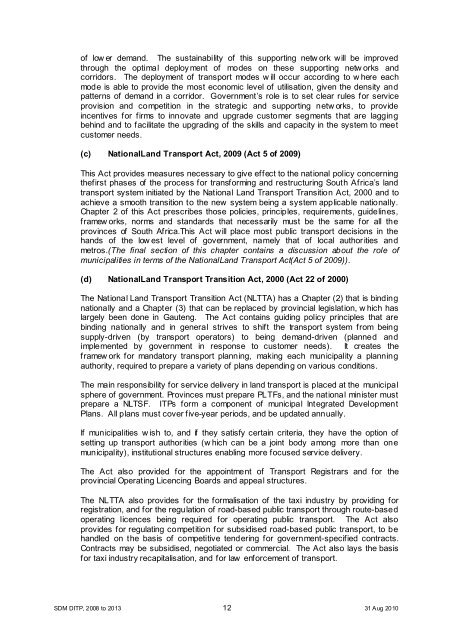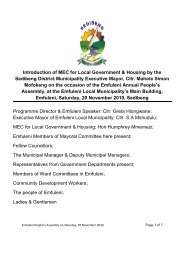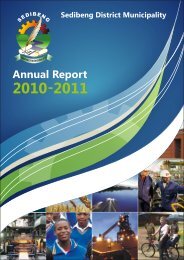Chapter 11 - Sedibeng District Municipality
Chapter 11 - Sedibeng District Municipality
Chapter 11 - Sedibeng District Municipality
Create successful ePaper yourself
Turn your PDF publications into a flip-book with our unique Google optimized e-Paper software.
of low er demand. The sustainability of this supporting netw ork will be improved<br />
through the optimal deploy ment of modes on these supporting netw orks and<br />
corridors. The deployment of transport modes w ill occur according to w here each<br />
mode is able to provide the most economic level of utilisation, given the density and<br />
patterns of demand in a corridor. Government’s role is to set clear rules for service<br />
provision and competition in the strategic and supporting netw orks, to provide<br />
incentives for firms to innovate and upgrade customer segments that are lagging<br />
behind and to facilitate the upgrading of the skills and capacity in the system to meet<br />
customer needs.<br />
(c) NationalLand Transport Act, 2009 (Act 5 of 2009)<br />
This Act provides measures necessary to give effect to the national policy concerning<br />
thefirst phases of the process for transforming and restructuring South Africa’s land<br />
transport system initiated by the National Land Transport Transition Act, 2000 and to<br />
achieve a smooth transition to the new system being a system applicable nationally.<br />
<strong>Chapter</strong> 2 of this Act prescribes those policies, principles, requirements, guidelines,<br />
framew orks, norms and standards that necessarily must be the same for all the<br />
provinces of South Africa.This Act will place most public transport decisions in the<br />
hands of the low est level of government, namely that of local authorities and<br />
metros.(The final section of this chapter contains a discussion about the role of<br />
municipalities in terms of the NationalLand Transport Act(Act 5 of 2009)).<br />
(d) NationalLand Transport Transition Act, 2000 (Act 22 of 2000)<br />
The National Land Transport Transition Act (NLTTA) has a <strong>Chapter</strong> (2) that is binding<br />
nationally and a <strong>Chapter</strong> (3) that can be replaced by provincial legislation, w hich has<br />
largely been done in Gauteng. The Act contains guiding policy principles that are<br />
binding nationally and in general strives to shift the transport system from being<br />
supply-driven (by transport operators) to being demand-driven (planned and<br />
implemented by government in response to customer needs). It creates the<br />
framew ork for mandatory transport planning, making each municipality a planning<br />
authority, required to prepare a variety of plans depending on various conditions.<br />
The main responsibility for service delivery in land transport is placed at the municipal<br />
sphere of government. Provinces must prepare PLTFs, and the national minister must<br />
prepare a NLTSF. ITPs form a component of municipal Integrated Development<br />
Plans. All plans must cover five-year periods, and be updated annually.<br />
If municipalities w ish to, and if they satisfy certain criteria, they have the option of<br />
setting up transport authorities (w hich can be a joint body among more than one<br />
municipality), institutional structures enabling more focused service delivery.<br />
The Act also provided for the appointment of Transport Registrars and for the<br />
provincial Operating Licencing Boards and appeal structures.<br />
The NLTTA also provides for the formalisation of the taxi industry by providing for<br />
registration, and for the regulation of road-based public transport through route-based<br />
operating licences being required for operating public transport. The Act also<br />
provides for regulating competition for subsidised road-based public transport, to be<br />
handled on the basis of competitive tendering for government-specified contracts.<br />
Contracts may be subsidised, negotiated or commercial. The Act also lays the basis<br />
for taxi industry recapitalisation, and for law enforcement of transport.<br />
SDM DITP, 2008 to 2013 12 31 Aug 2010
















